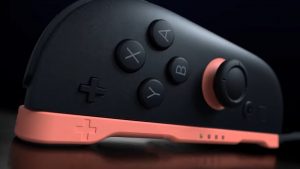Alienware has been taking a run at the high-end peripheral market recently with its Pro line of gaming accessories. Following the Alienware Pro Wireless keyboard and Alienware Pro Wireless mouse, we now have the Alienware Pro Wireless gaming headset, presumably completing a line up of peripherals that Alienware hopes will tempt buyers away from other offerings and towards its ever-recognisable xenomorph branding.
This is a wireless ANC gaming set, and I first got a sneak peak at one during Gamescom all the way back in August of last year. The Alienware team was very keen to point out the graphene-coated drivers, the concessions to comfort, and the overall build quality of what is hoped to be a set that makes a splash in the fiercely competitive gaming headset market.
For $230/£222 it’s quite a pricey affair as gaming headsets go, so I was keen to get my hands on one and put it through the ringer myself. There’s some tough competition available for under $230, so it needs to swing for the fences if it’s going to make its mark.
If there’s one word I’d use to describe my initial impressions of the Alienware Pro when I pulled it from the box, it’d be squidgey. If there was another word I’d use to describe this supposedly all-black model, it would be grey. It’s a difficult thing to show in photos, but I handed this set around the office to check it wasn’t just my ageing eyes, and we all agreed it was a blue-grey sort of finish rather than a black one.
It’s not a big deal, I suppose. But as someone who’s previously asked Alienware to send me black Pro peripherals for review after an onslaught of dirt-revealing white ones, the irony isn’t lost on me that I was finally sent something that’s supposed to be black (or “Dark Side of the Moon” in Alienware-speak), but doesn’t really look like it.
Anyway, back to squidgey. The memory foam earcups have a significant amount of give to them, which makes them very pleasing to put upon your lugs. The inner headband material is the same, so overall it’s a very comfy, slightly bouncy, somewhat comforting thing to wear.
It’s also quite light, which means you can happily wear this set all day without noticing it’s there.
The clamping force is fairly well-judged too, so there’s no worries about it falling off while you hunt for a cable—although it might be a little tight for those of you with larger heads. Not that you’ll need to plug it in often, as the Pro features a 75-hour battery life.
(Image credit: Future)
(Image credit: Future)
(Image credit: Future)
That’s up there with other premium headsets, although not a patch on the 300-hour battery life of our favorite wireless gaming headset, the HyperX Cloud Alpha Wireless. I still don’t know how HyperX has managed battery life that impressive while others languish, but I reckon 75 hours is still pretty good regardless for a premium set of phones.
The Alienware Pro also features dual wireless connections, both 2.4 GHz RF and Bluetooth 5.3. Included in the box is a tiny blue-LED-lit USB Type-C wireless dongle along with a USB Type-A adapter—which comes as a merciful relief for someone like me who still only has one proper USB Type-C port on the back of their machine.
This is a noise-cancelling set, and the effect is excellent. It doesn’t provide complete silence, but it mutes the clack of a mechanical gaming keyboard nicely and provides some much-needed respite on the odd train journey, too. In fact, thanks to the included Bluetooth connection, the Alienware makes for a decent set of travelling headphones.
I’m all for multi-usage headsets, and this one’s got a lot of desirable features for exactly this sort of real-world use.
(Image credit: Future)
Connects, disconnects, microphone mutes and more are announced by an irritatingly cheery voice, with the same sort of smooth tone that a hotel receptionist would use to tell you they can’t find your booking. This is the most minor of critiques, but I would describe this set as quite chatty. Perhaps it’s just the upbeat nature of the vocals grinding against my ears, but the Pro does seem to announce what it’s doing more often than some.
Speaking of sound, there’s some odd audio tuning at work here—and it’s had me wrinkling my nose at points. The 50 mm graphene-coated drivers are quite capable of delivering some seriously punchy bass at low to medium volumes, and for gaming this means whomping great menu effects, weighty explosions, and chonky gunfire. All very enjoyable.
(Image credit: Future)
However, at higher volumes things become chaotic, with the bass dropping back and the mix suffering overall. Run The Jewels’ “out of sight (feat 2 Chainz)” is a go-to on my headphone testing playlist for huge gobs of skull-rattling low-end, and the initial synthesised kick drum hits deliver a promising amount of sub-bass weight.
As soon as the track hits full swing and you crank the volume up, though, the low-end mix disappears, and other frequencies higher up the scale start to break up.
The Pro Wireless can become properly loud, and as a volume-enjoyer, this is much appreciated. Many modern headsets leave me wanting, but this one can push to eardrum-destroying levels. It’s just a shame the low end disappears with it, meaning you only really get the full weighty effect at around 40% volume and below.
(Image credit: Future)
(Image credit: Future)
On this particular set, that’s still pretty loud, and probably more than enough for many—but should you wish to push things to higher levels, be prepared to hear a messy sonic result, with some perceptible distortion, too.
It’s all a bit crunchy at the top, like the drivers are being pushed beyond their limits too early on the scale—so the much-appreciated headroom goes to waste.
The Alienware Pro exists in a bit of a no-man’s land, where it’s expensive enough that its flaws can’t be ignored, but still possesses enough merit to be worthy of consideration
I’m often criticised by my partner for listening to music too loudly on my headphones. As a result, I’ve probably got a skewed metric as to what volume most people regard as acceptable, but I’ve got a feeling the Alienware’s 40% cut off is probably it.
It’s still fairly loud, and you get all the weighty chonk without sacrificing the quality of the treble or the mix overall. But I’m forced to wonder why these drivers are allowed to push themselves into frequency-crushing ranges in the first place.
The microphone is a removable boom unit, and I’d describe it as muffled, at best. The Alienware Pro shows up as two different audio devices, labelled Wireless Game and Wireless Chat, but no matter which I set it in, the results are poor. A shame, although it’s still not the worst gaming headset mic I’ve heard.
Still, as my testing shows, it’s pretty awful by default—although it does come with a fairly aggressive noise cancelling feature that I’ve turned off for the test recording, as it has a tendency to clip a little too easily. Regardless, however I play with the settings (beyond breaking out the VST plugins, which seems a step too far for a headset mic) the results are disappointing.
✅ You’re looking for comfort: The Alienware Pro is squidgey, light, and well-judged when it comes to clamping force. You can quite happily wear it all day without noticing it’s there.
✅ You like a bit of bass at a reasonable volume: Keep the Pro at reasonable levels and the bottom end is surprisingly powerful.
❌ You listen to music at high volumes: While the Pro can get plenty loud, it loses a lot of low-end weight as a result, and higher frequencies can begin to break up.
❌ You’re on a budget: $230 is fairly pricey for a gaming headset, and there’s cheaper competition that perform better overall.
❌ You want a good microphone: No matter how I fiddled with the included settings, I couldn’t get anything but a sub-standard result out of the Alienware’s boom mic.
Taking all this into account, there’s still plenty to like about the Pro. It’s a very comfortable gaming headset that, if the volume is left in reasonable ranges, performs well when it comes to overall sound. And while I’m not a huge fan of its blue-grey looks, it’s still discrete enough that you can wear it in public without inviting comment.
But those high volume issues are disappointing, there’s no denying it. I’ve still been enjoying using the Alienware Pro as a daily driver while I work, as that’s the time I listen to music at a respectable level so as not to distract myself too much from my train of thought. For this usage it’s performed with aplomb, and it’s a comfy companion for some late-night gaming, too.
But I’d still rather have the superb battery life and excellent audio handling of the HyperX Cloud Alpha Wireless for a fair bit cheaper. Or, if you can stretch your budget further, the supreme sonic excellence of the Audeze Maxwell.
The Alienware Pro exists in a bit of a no-man’s land, where it’s expensive enough that its flaws can’t be ignored, but still possesses enough merit when it comes to comfort, design, and reasonable-volume listening to be worthy of some consideration.
Still, every time a track I love appears on my playlist and I reach for the volume knob, I can’t help but wince. And, while this set has something to recommend it for, I can’t get past the idea that, for $230, you’d be better off looking at something that can handle its liquor, so to speak, a little better than this.










